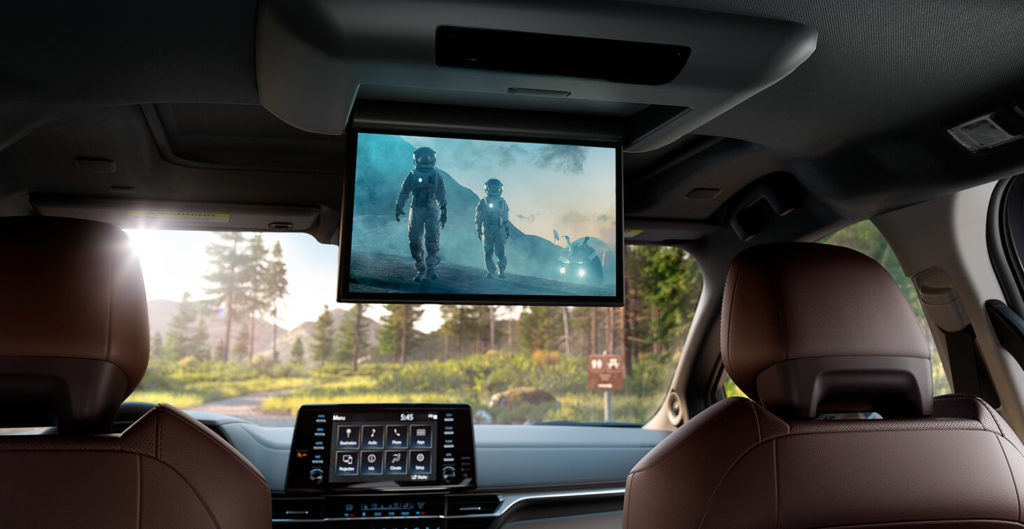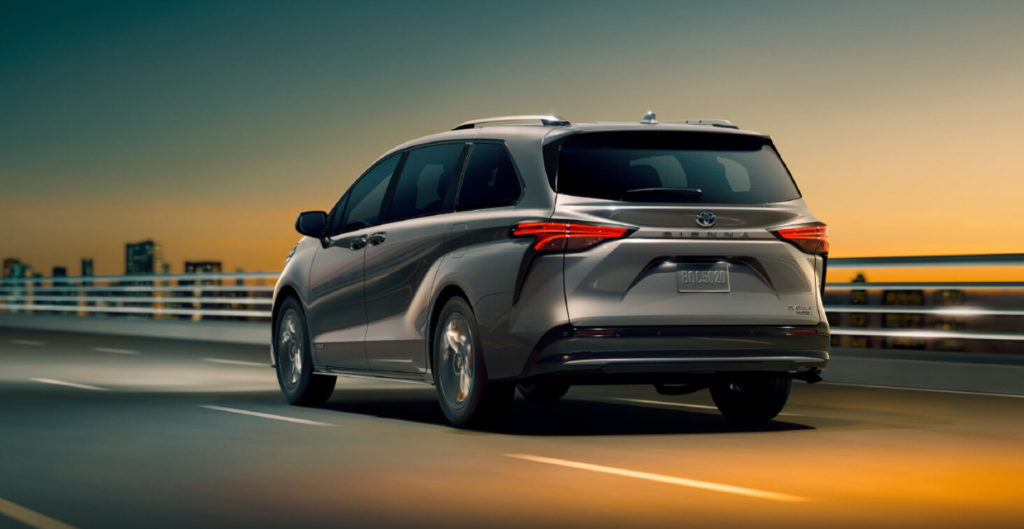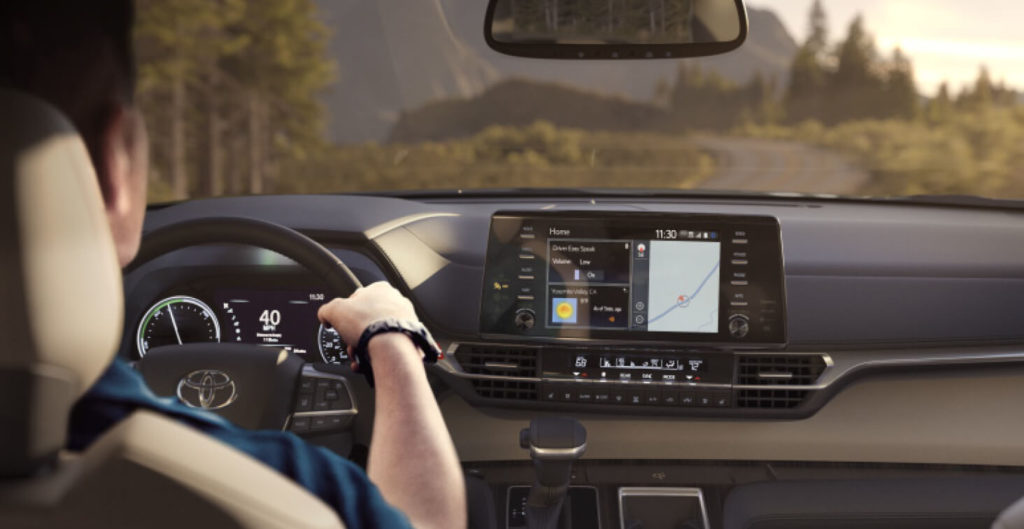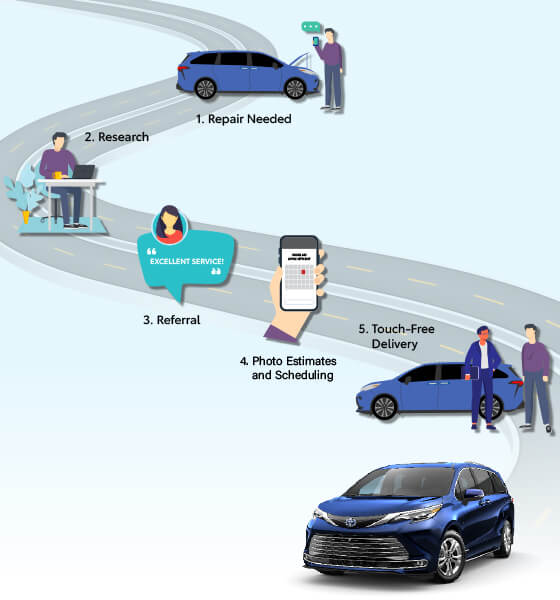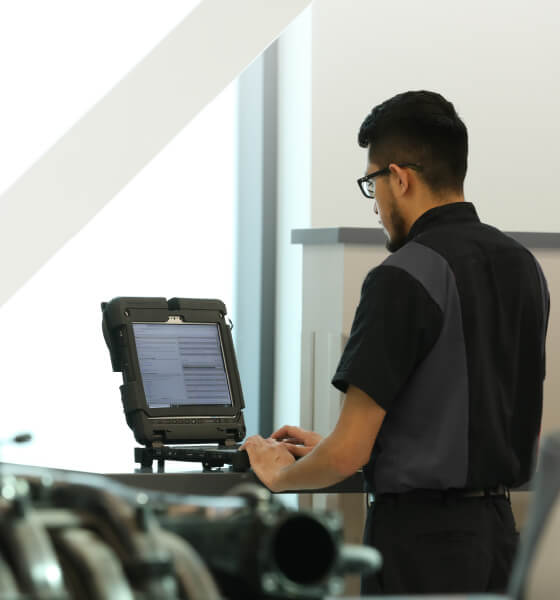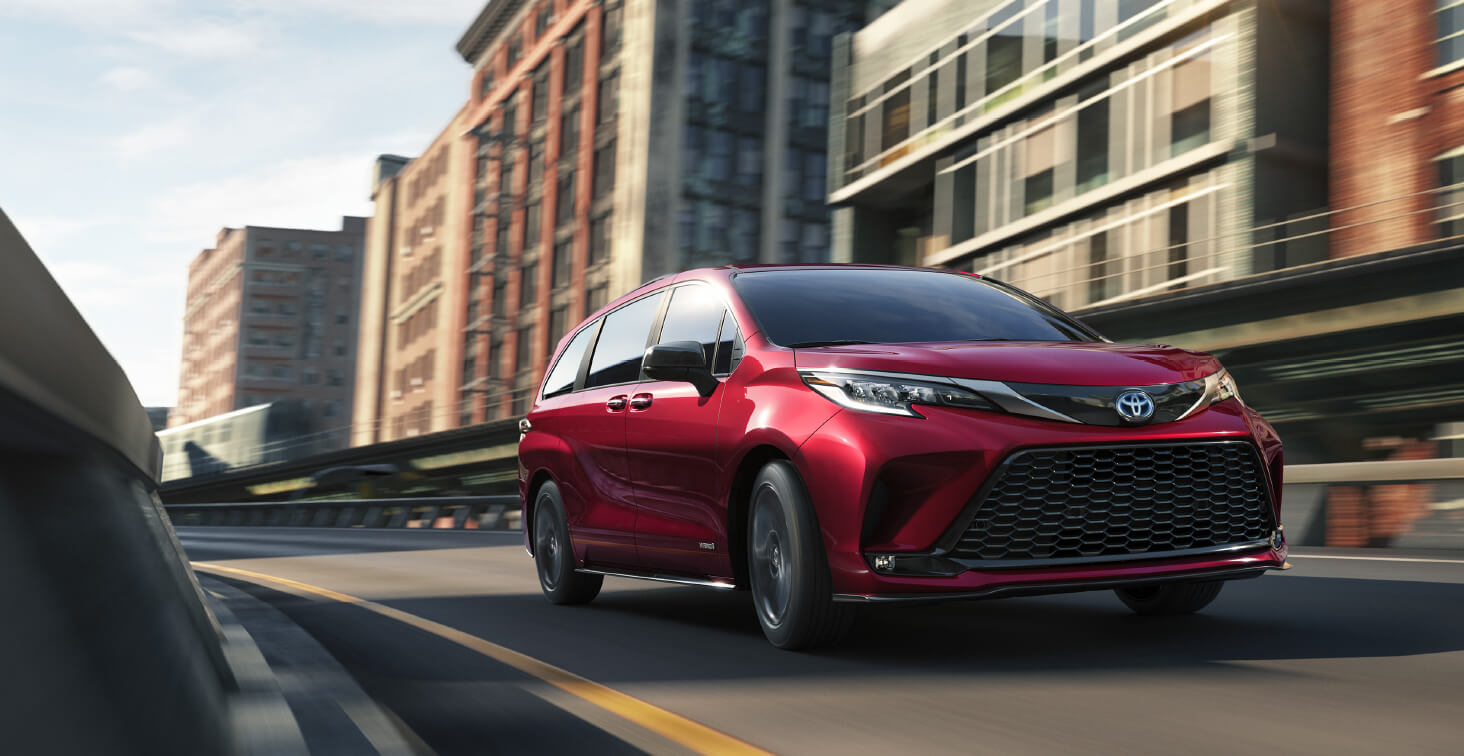
Collision Pros Magazine 2021 | ISSUE 1
ALL-NEW 2021 TOYOTA SIENNA
Taking Technology To New Levels
With focus on space and style, the all-new 2021 Toyota Sienna redefines the minivan segment to support a wider array of life stages and activities.
The fourth generation Sienna was designed and engineered in the U.S., and has an array of new technology that raises the bar in its segment for style, safety, comfort, versatility and fuel economy. The 2021 Sienna comes in five trim levels—LE, XLE, XSE, Limited and Platinum—and content varies greatly by trim. When one comes into your facility, the first thing you should do is confirm the trim level, but there are also some additional key features you need to be aware of.
BUILT ON A PROVEN PLATFORM

The 2021 Sienna is built on Toyota’s Global Platform K (TNGA-K), which is shared with the Camry, Avalon, Venza and RAV4. The TNGA-K platform owes its inherent strength to the extensive use of hot-stamped sheet steel, ultra-high tensile strength steel, as well as the extensive use of aluminum components to reduce weight and ensure a rigid body structure.
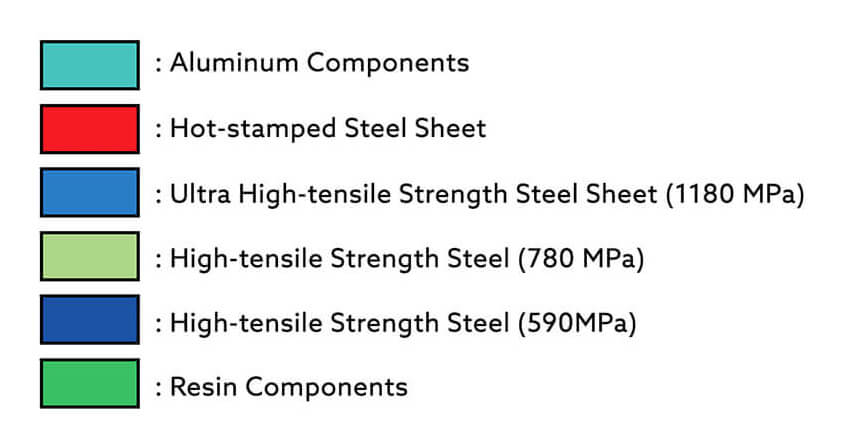
Case in point: The sliding doors feature aluminum construction to keep the weight down. As you know, repairing an aluminum door panel is different than a repair done on a steel door. You have to consider the size and the location of the damage, as well as the accessibility to the damage before proceeding.
When manufacturing the Sienna, the factory uses Laser Pinning Welding (LPW) on various parts of the chassis to bond the first and second steel sheets from the outside (the outer panel and reinforcement). LPW is always used near spot welding. The outer appearance of LPW is similar to Laser Screw Welding—LPW can be differentiated from Laser Screw Welding because the weld has a smaller diameter.
For LPW repairs, use small diameter plug welding and follow the instructions in the body repair manual. Refer to the “Precautions for Welding” Document ID: RM100000001TW4D for more information.

For more information sign into TIS: https://techinfo.toyota.com/
HYBRID PLATFORM
The 2021 Toyota Sienna is a Super Ultra Low Emission Vehicle (SULEV) with the sealed Nickel-Metal Hydride (Ni-MH) hybrid battery located under the seats.
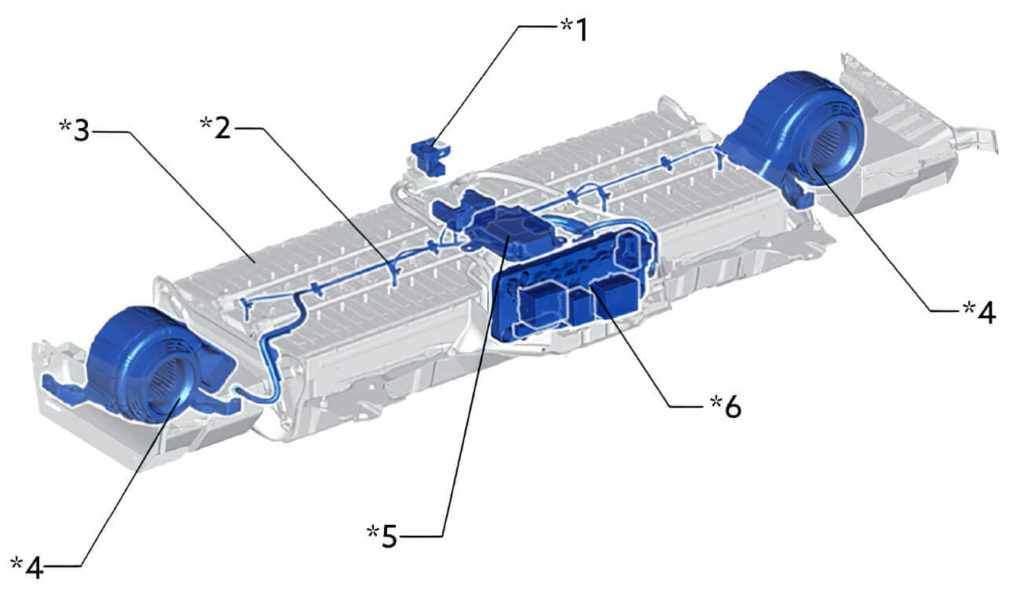
For more information For more information sign into: https://techinfo.toyota.com/
The Toyota Sienna comes in both front-wheel drive and available Electronic On-Demand All-Wheel Drive. Instead of a traditional transfer case and driveshaft to deliver power to the rear wheels, Sienna employs a separate rear-mounted electric motor that powers the rear wheels when needed. It works seamlessly, distributing up to 80 percent of driving force to the rear wheels, which helps suppress front wheel slip during off-the-line starts. This system also makes repairs easier, as you don’t have to deal with a transfer case or rear driveshaft.
AVAILABLE NEW FEATURES
The new Toyota Sienna abounds with technological features to help make driving safer and more convenient. The challenge for you is that when one comes in for collision repairs, you must ensure those features are working “as new” when you deliver the repaired vehicle. That’s why we recommend checking any of the systems that may be affected by an accident before you start work and log any issues you find. Then re-check the systems again once repairs are complete. New features include:
- Power tilt and telescoping steering column with heated steering wheel (Platinum)
- Digital rear-view mirror—it functions as a standard mirror until rear-seat passengers or cargo block the view; then, at the touch of a switch, the obstructions disappear, replaced by the camera’s image from behind the vehicle (optional on Limited and Platinum)
- Hands-free kick-open and close dual power sliding side doors1 (standard on XLE, XSE, Limited and Platinum)
- Hands-free kick-open rear liftgate1 (standard on XLE, XSE, Limited and Platinum)—installation of a tow hitch receiver or other accessories located near the rear bumper may require disabling or removing the kick sensor
- 10-inch color head-up display that is controlled via voice recognition and steering wheel switch (Platinum trim level)
- Optional 1,500-watt inverter with 120V AC outlet2
TOYOTA SAFETY SENSE™ 2.0 FEATURES
All 2021 Toyota Sienna trim levels offer a full suite of Toyota Safety Sense 2.03 features, including:
- Pre-Collision System with Low-Light Vehicle and Pedestrian Detection and Bicycle Detection (PCS)4
- Full-Speed Range Dynamic Radar Cruise Control (DRCC)5
- Lane Departure Alert with Steering Assist (LDA w/SA)6
- Automatic High Beams (AHB)7
- Lane Tracing Assist (LTA)8
- Road Sign Assist (RSA)9
Other Advanced Safety Features
- Blind Spot Monitor (BSM)10 with Rear Cross-Traffic Alert (RCTA)11
- Hill Start Assist Control (HAC)12
- 10 airbags13 — includes driver and front passenger Advanced Airbag System, driver, front passenger and second-row outboard seat-mounted side airbags, driver knee airbag, front passenger seat-cushion airbag and side curtain airbags
- XLE, XSE, Limited and Platinum trim levels add Front and Rear Parking Assist with Automated Braking (PA w/AB)14
To further aid outward visibility, the Platinum trim comes standard with the Bird’s Eye View Camera15 with Perimeter Scan and overhead 360-degree view. You need to be aware of all these cameras, as they require precise alignment and calibration after a collision.
Know The Toyota Sienna Before Starting A Repair
Be sure to follow the recommended procedures based on the parts you’re working with to ensure you return a vehicle that looks perfect, functions as new and maintains Toyota safety standards.
Disclaimer & Footnotes
- Installation of a tow hitch receiver or other accessories located near the rear bumper may require disabling or removing the kick sensor, and the sensor operation setting in your vehicle should be turned off. Water, weather, dirt, and other conditions also may cause the sensor to not operate properly or to operate unintentionally. See Owner’s Manual for limitations.
- Rated for 1500 watts shared between both outlets. See Owner’s Manual for additional limitations and details.
- Toyota Safety Sense™ effectiveness is dependent on many factors including road, weather and vehicle conditions. Drivers are responsible for their own safe driving.
- The TSS Pre-Collision System is designed to help avoid or reduce the crash speed and damage in certain frontal collisions only. It is not a substitute for safe and attentive driving. System effectiveness is dependent on many factors, including road, weather and vehicle conditions. Feature availability may vary by vehicle and trim.
- Dynamic Radar Cruise Control (DRCC) is designed to assist the driver and is not a substitute for safe and attentive driving. System effectiveness is dependent on many factors, including road, weather and vehicle conditions. Feature availability may vary by vehicle and trim.
- Lane Departure Alert (LDA) is designed to read visible lane markers under certain conditions and provide visual and audible alerts when lane departure is detected. It is not a collision-avoidance system or a substitute for safe and attentive driving. System effectiveness is dependent on many factors, including road, weather and vehicle conditions.
- Automatic High Beams operate at speeds above 25 mph. Factors such as a dirty windshield, weather, lightning, and terrain limit effectiveness, requiring the driver to manually operate the high beams. Feature availability may vary by vehicle and trim.
- Lane Tracing Assist (LTA) is designed to read visible lane makers and detect other vehicles under certain conditions. It is only operational when DRCC is engaged.
- Do not rely exclusively on Road Sign Assist (RSA). It is not a substitute for safe and attentive driving. System effectiveness is dependent on many factors, including road, weather and vehicle conditions. Feature availability may vary by vehicle and trim.
- Do not rely exclusively on the Blind Spot Monitor. Always look over your shoulder and use your turn signal. There are limitations to the function, detection and range of the monitor. See Owner’s Manual for additional limitations and details.
- Do not rely exclusively on the Rear Cross-Traffic Alert system. Always look over your shoulder and use your mirrors to confirm rear clearance. There are limitations to the function, detection and range of the system. See Owner’s Manual for additional limitations and details.
- Hill Start Assist Control is designed to help minimize backward rolling on steep ascents. It is not a substitute for safe driving judgement and practices. Factors including speed, grade, surface conditions and driver input can all affect whether HAC will be effective in preventing a loss of control.
- Airbag systems are Supplemental Restraint Systems and are designed to inflate only under certain conditions and in certain types of severe collisions.
- At speeds of 9 mph or less, Front and Rear Parking Assist with Automatic Braking (PA w/AB) is designed to assist drivers in avoiding potential collisions with nearby static objects when the vehicle is in Drive or Reverse and approaching crossing vehicles when the vehicle is in Reverse. Do not overly rely on PA w/AB. Always look around outside the vehicle and use mirrors to confirm clearance. Certain vehicle and environmental factors, including an object or vehicle’s shape, size and composition, may affect the system’s effectiveness.
- The Panoramic View Monitor does not provide a comprehensive view of the area surrounding the vehicle. You should also look around outside your vehicle and use your mirrors to confirm surrounding clearance. Environmental conditions may limit effectiveness and view may become obscured. See Owner’s Manual for additional limitations and details.
